Answers - Hesitation, Stumble, won't accelerate, no power, misfires, etc... Fixed
#1
Junior Member
Thread Starter
Answers - Hesitation, Stumble, won't accelerate, no power, misfires, etc... Fixed
I am posting this to share my recent experience with my '99 CLK430. I am an experienced mechanic. I've been working on cars/engines for more than 15 years, I attended UTI when I was young, but I do not work in the field. This is my first MB and I did not know the ins and outs well enough to jump right in and find/fix the problem I was having. I was very frustrated by the lack of response that I got on both MBWorld.org and Mercedesforum.com; as well as the general lack of detailed information available on the internet. I hope this provides some valuable information and references, and also helps anyone that may have any of the problems below.
I haven't owned this car very long, less than 2 years. I had an incident when I first got the car, where I apparently got some low-quality fuel, and the car began having acceleration problems. Talked to the local private MB shop, and they poured in a can of BG44K (Fuel System Cleaner), and that solved the problem. This problem started out the same way, and I thought I probably got some bad fuel again. BG44K did not fix the problem, so I changed out the fuel filter because it was about due, and also to make sure that it hadn't been plugged if indeed I had gotten bad fuel. This did not fix the problem either, and then it progressed.
This is when the serious problems began. It lost the ability to accelerate above about 3500 RPM, and also quit accelerating when I gave it more than about 50% throttle, and generally lacked power.. It started fine, idled okay, and ran decently as long as it was under (around) 3500 RPM and less than 50% throttle. Let me clarify, that at this point, I had gone through and done a basic inspection and there was nothing apparent that would be causing the problem. I even tested for vacuum leaks with propane and mass air cleaner. This is when I was advised to try replacing the MAF, I did, and it did not fix the problem. I began researching more about the car and the problem I was having. One day while I was driving, the car stalled and at first would not restart. It finally restarted but would barely accelerate. Once I got it home, I started troubleshooting and below is the sequence of events that followed and what I found:
I haven't owned this car very long, less than 2 years. I had an incident when I first got the car, where I apparently got some low-quality fuel, and the car began having acceleration problems. Talked to the local private MB shop, and they poured in a can of BG44K (Fuel System Cleaner), and that solved the problem. This problem started out the same way, and I thought I probably got some bad fuel again. BG44K did not fix the problem, so I changed out the fuel filter because it was about due, and also to make sure that it hadn't been plugged if indeed I had gotten bad fuel. This did not fix the problem either, and then it progressed.
This is when the serious problems began. It lost the ability to accelerate above about 3500 RPM, and also quit accelerating when I gave it more than about 50% throttle, and generally lacked power.. It started fine, idled okay, and ran decently as long as it was under (around) 3500 RPM and less than 50% throttle. Let me clarify, that at this point, I had gone through and done a basic inspection and there was nothing apparent that would be causing the problem. I even tested for vacuum leaks with propane and mass air cleaner. This is when I was advised to try replacing the MAF, I did, and it did not fix the problem. I began researching more about the car and the problem I was having. One day while I was driving, the car stalled and at first would not restart. It finally restarted but would barely accelerate. Once I got it home, I started troubleshooting and below is the sequence of events that followed and what I found:
Last edited by senorking; 03-24-2011 at 09:26 PM.
The following users liked this post:
Shadwell (05-05-2016)
#2
Junior Member
Thread Starter
1. Bad Gas:
I opened the gas cap and took a whiff, all I could smell was VERY OLD gasoline, which smells like varnish. I filled a 5-gallon gas can, and added a bottle of fuel stabilizer. Poured that into the tank and gave it a few minutes to react. I restarted the car, and after it cleared the rest of that crap out of the fuel lines, it returned to “normal” where ran fine as long as it was under 3500rpm and 50% throttle.
2. Diagnostics and Sensors:
Up until this time, it did not trigger a CEL, finally the light came on. I ordered an ELM327 OBD-II adapter, and analyzed the trouble codes and the readings from all the sensors. The only codes it gave were Cylinder Misfire on 1, 2, 3, and 5; along with a Multiple Cylinder Misfire Code. All the sensors appeared to be functioning properly, and I did not see anything unusual. I posted graphs of the sensor data to see if anyone saw anything unusual, and I got no replies.
3. Catalytic Converters and Exhaust Backpressure:
I found a post on one of the MB forums, where a person who identified himself as an ASE Master Tech, described the EXACT set of symptoms that my car was having. He also got no replies. I emailed to ask if he found the cure, and he advised that both catalytic converters were plugged, and after replacing them the problem was solved. Please see his post:
http://mercedesforum.com/forum/gener...45/#post147505
So I removed the upstream O₂ sensors one at a time, and threaded in a pressure guage to check exhaust backpressure. I checked the backpressure first with the engine cold, and again with the cats at operating temperature, it was so low both times it barely registered on the guage. (Yes, I used a guage with a fine enough resolution to measure as low as 1-2 PSI)
4. Vacuum Lines:
I decided to take a closer look at the vacuum lines and valves, especially as they had linkage that connected to the manifold. (I did not suspect a vacuum leak because of the normal idle, the normal readings on the diagnostics, and the fact that no leak was indicated when testing with propane and solvent.) As I began carefully inspecting the lines, they looked fine. But when I flexed them they were full of cracks. Some of these cracks were all the way through the wall of the tube, but still were not apparent until the tube was flexed. Upon further inspection, I found a line that actually had a open hole in it, but it was on the backside where it was not visible.
(I should mention at this point that I live in the southwest, where it is VERY HOT and VERY DRY, both of which are bad for rubber, plastic, vinyl, leather, and other similar materials. The heat causes rubber to decay rapidly making it brittle and causing it to shrink. This car has repeatedly seen ambient Temps of 95 – 120 degrees F.)
These vacuum lines are used for the control of the variable intake system, which effectively changes the length of the intake runner, by opening and closing valves in the manifold. Since I had no vacuum going to this device (due to the hole in the line), the valves were stuck open all the time. I decided to replace every vacuum line on the engine. One line however attaches in a port on the bottom side of the manifold. This line sheared off flush with the bottom of the manifold when I touched it, making it impossible to remove with the manifold on the car. The tube connects to a port that is actually recessed a couple of inches back into the manifold. In order to repair and replace the line, I had to remove the manifold.
5. Removing the Manifold:
Upon removing the manifold, I discovered that both the intake runners, the intake ports, and the intake valves were all coated with sand. (While cleaning my shorts, I began contemplating the logistics of selling it piece by piece on eBay.) Because the manifold is not supposed to be serviceable, I decided it would be best to order a new one. I happened to find one on eBay that night for $300 with a guarantee, so I ordered it. Then I decided to split my manifold open and take a look at it (seeing the inside of the manifold and how it was designed, I started to realize the bad vac lines were probably the source of my problem). Indeed, it was full of sand.
All the black stuff in the photo is sand covered in gas/oil...
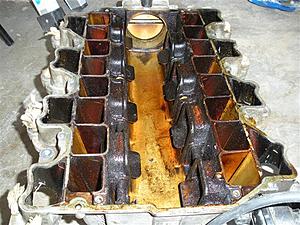
6. Removing the Sand:
I was lucky and only 2 cylinders had open intake valves. I spent an entire afternoon carefully cleaning the ports and valves with solvent and paper-towels. I adapted a wet-vac down to a clear, 1/4” line that I could insert into the port to remove sand and solvent during this process. I carefully wiped the walls of the ports with a paper-towel soaked in solvent. Then I sprayed the walls and the valves with B-12 Chemtool, while suctioning at the bottom of the port.
On the cylinders that had open intake valves, I removed a spark plug, and inserted the suction line into the cylinder. I did the same as on the other cylinders, but flushed the port with only small amounts of solvent, with the suction on to instantly remove the fluid/sand from the cylinder. The clear tubing allowed me to make sure that I was removing about the same volume of fluid as I was spraying in.
7. Spark Plugs:
While I had the engine partially disassembled, I decided to replace the spark plugs. They were coated with the same oily, sandy deposits that the ports were, so this turned out to be a good idea. When I was removing the coil packs, in order to access the plugs, I noticed that one of the plug-wires on cylinder 7 was not fully seated on the coil pack. The contacts were not in contact, and so it had been arcing creating a buildup of ashy deposits on both contacts, and also apparently creating a fair amount of heat as the plastic housing around the contact on the coil itself was distorted and cracked. The crack is only in the plastic around the contact, and not in the housing around the coil, and does not appear to affect the functionality of the coil. So I carefully filed down the deposits on both contacts until I had exposed bare metal.
8. Intake Gaskets:
I took a little time to clean up the new manifold as best as I could, again shooting solvent through the runners, and suctioning out what I could. I installed the throttle valve using a new O-ring, and then I installed the new manifold, and finished reassembling everything. During reassembly, I replaced all the rubber seals between the throttle actuator and the air filter housing. Again, the heat had caused all these seals to shrink and harden, leaving a gap for air to sneak by, bypassing the air filters, and in the case of the lower seals, also bypassing the MAF. This was probably the main cause of sand getting sucked into the motor.
9. Fuel Filter:
Upon restart, it ran much better but still had a stumble. The next day I filled up with gas, and added a good fuel system cleaner. As the solvent did it's work, it started running a little rough and started to throw misfire codes again for a short period, followed by triggering the CEL with no codes, and then returned pretty much to normal. The engine could rev all the way to redline again. But if I got above about 70% throttle, it would hesitate, although not nearly as bad as before. I hooked up the diagnostics and floored it and looked at all the sensor readings. Everything was okay except that the O₂ sensors were indicating a lean condition. I suspected fuel pressure, so I waited until I had used up all the gas with the fuel system solvent in it, and then replaced the filter.
10. Voila!
The car is back 100% back to normal with full power. And it runs smoother than it ever has since I've owned it.
A diagram of how the variable intake works:
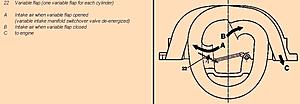
The black stuff in all these photos is sand covered with gas/oil...
This is the lower portion of the manifold, you can see the valves that control the variable intake. When they are open air enters through the valve, bypassing most of the length of the runner. The valley running down the middle is actually the top of a tank which acts as a vacuum reservoir.

This is the upper portion, or top, of the manifold. The ports down the center are where air enters when the valves are closed.
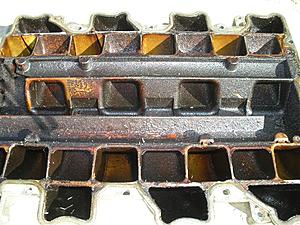
Here are some shots of the ports, you can see the buildup of sand on the walls and valves.
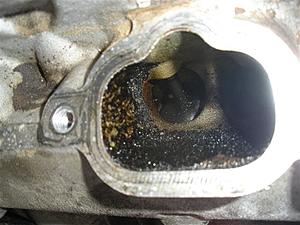
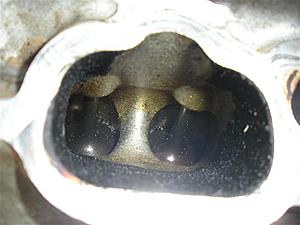
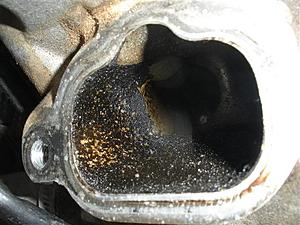
Here is one of the ports after cleaning:

A couple shots of the motor with the intake off:
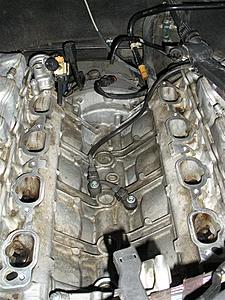
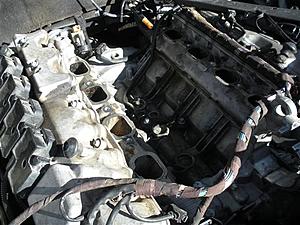
This is me when I realized there was sand in the motor...

I opened the gas cap and took a whiff, all I could smell was VERY OLD gasoline, which smells like varnish. I filled a 5-gallon gas can, and added a bottle of fuel stabilizer. Poured that into the tank and gave it a few minutes to react. I restarted the car, and after it cleared the rest of that crap out of the fuel lines, it returned to “normal” where ran fine as long as it was under 3500rpm and 50% throttle.
2. Diagnostics and Sensors:
Up until this time, it did not trigger a CEL, finally the light came on. I ordered an ELM327 OBD-II adapter, and analyzed the trouble codes and the readings from all the sensors. The only codes it gave were Cylinder Misfire on 1, 2, 3, and 5; along with a Multiple Cylinder Misfire Code. All the sensors appeared to be functioning properly, and I did not see anything unusual. I posted graphs of the sensor data to see if anyone saw anything unusual, and I got no replies.
3. Catalytic Converters and Exhaust Backpressure:
I found a post on one of the MB forums, where a person who identified himself as an ASE Master Tech, described the EXACT set of symptoms that my car was having. He also got no replies. I emailed to ask if he found the cure, and he advised that both catalytic converters were plugged, and after replacing them the problem was solved. Please see his post:
http://mercedesforum.com/forum/gener...45/#post147505
So I removed the upstream O₂ sensors one at a time, and threaded in a pressure guage to check exhaust backpressure. I checked the backpressure first with the engine cold, and again with the cats at operating temperature, it was so low both times it barely registered on the guage. (Yes, I used a guage with a fine enough resolution to measure as low as 1-2 PSI)
4. Vacuum Lines:
I decided to take a closer look at the vacuum lines and valves, especially as they had linkage that connected to the manifold. (I did not suspect a vacuum leak because of the normal idle, the normal readings on the diagnostics, and the fact that no leak was indicated when testing with propane and solvent.) As I began carefully inspecting the lines, they looked fine. But when I flexed them they were full of cracks. Some of these cracks were all the way through the wall of the tube, but still were not apparent until the tube was flexed. Upon further inspection, I found a line that actually had a open hole in it, but it was on the backside where it was not visible.
(I should mention at this point that I live in the southwest, where it is VERY HOT and VERY DRY, both of which are bad for rubber, plastic, vinyl, leather, and other similar materials. The heat causes rubber to decay rapidly making it brittle and causing it to shrink. This car has repeatedly seen ambient Temps of 95 – 120 degrees F.)
These vacuum lines are used for the control of the variable intake system, which effectively changes the length of the intake runner, by opening and closing valves in the manifold. Since I had no vacuum going to this device (due to the hole in the line), the valves were stuck open all the time. I decided to replace every vacuum line on the engine. One line however attaches in a port on the bottom side of the manifold. This line sheared off flush with the bottom of the manifold when I touched it, making it impossible to remove with the manifold on the car. The tube connects to a port that is actually recessed a couple of inches back into the manifold. In order to repair and replace the line, I had to remove the manifold.
5. Removing the Manifold:
Upon removing the manifold, I discovered that both the intake runners, the intake ports, and the intake valves were all coated with sand. (While cleaning my shorts, I began contemplating the logistics of selling it piece by piece on eBay.) Because the manifold is not supposed to be serviceable, I decided it would be best to order a new one. I happened to find one on eBay that night for $300 with a guarantee, so I ordered it. Then I decided to split my manifold open and take a look at it (seeing the inside of the manifold and how it was designed, I started to realize the bad vac lines were probably the source of my problem). Indeed, it was full of sand.
All the black stuff in the photo is sand covered in gas/oil...

6. Removing the Sand:
I was lucky and only 2 cylinders had open intake valves. I spent an entire afternoon carefully cleaning the ports and valves with solvent and paper-towels. I adapted a wet-vac down to a clear, 1/4” line that I could insert into the port to remove sand and solvent during this process. I carefully wiped the walls of the ports with a paper-towel soaked in solvent. Then I sprayed the walls and the valves with B-12 Chemtool, while suctioning at the bottom of the port.
On the cylinders that had open intake valves, I removed a spark plug, and inserted the suction line into the cylinder. I did the same as on the other cylinders, but flushed the port with only small amounts of solvent, with the suction on to instantly remove the fluid/sand from the cylinder. The clear tubing allowed me to make sure that I was removing about the same volume of fluid as I was spraying in.
7. Spark Plugs:
While I had the engine partially disassembled, I decided to replace the spark plugs. They were coated with the same oily, sandy deposits that the ports were, so this turned out to be a good idea. When I was removing the coil packs, in order to access the plugs, I noticed that one of the plug-wires on cylinder 7 was not fully seated on the coil pack. The contacts were not in contact, and so it had been arcing creating a buildup of ashy deposits on both contacts, and also apparently creating a fair amount of heat as the plastic housing around the contact on the coil itself was distorted and cracked. The crack is only in the plastic around the contact, and not in the housing around the coil, and does not appear to affect the functionality of the coil. So I carefully filed down the deposits on both contacts until I had exposed bare metal.
8. Intake Gaskets:
I took a little time to clean up the new manifold as best as I could, again shooting solvent through the runners, and suctioning out what I could. I installed the throttle valve using a new O-ring, and then I installed the new manifold, and finished reassembling everything. During reassembly, I replaced all the rubber seals between the throttle actuator and the air filter housing. Again, the heat had caused all these seals to shrink and harden, leaving a gap for air to sneak by, bypassing the air filters, and in the case of the lower seals, also bypassing the MAF. This was probably the main cause of sand getting sucked into the motor.
9. Fuel Filter:
Upon restart, it ran much better but still had a stumble. The next day I filled up with gas, and added a good fuel system cleaner. As the solvent did it's work, it started running a little rough and started to throw misfire codes again for a short period, followed by triggering the CEL with no codes, and then returned pretty much to normal. The engine could rev all the way to redline again. But if I got above about 70% throttle, it would hesitate, although not nearly as bad as before. I hooked up the diagnostics and floored it and looked at all the sensor readings. Everything was okay except that the O₂ sensors were indicating a lean condition. I suspected fuel pressure, so I waited until I had used up all the gas with the fuel system solvent in it, and then replaced the filter.
10. Voila!
The car is back 100% back to normal with full power. And it runs smoother than it ever has since I've owned it.
A diagram of how the variable intake works:

The black stuff in all these photos is sand covered with gas/oil...
This is the lower portion of the manifold, you can see the valves that control the variable intake. When they are open air enters through the valve, bypassing most of the length of the runner. The valley running down the middle is actually the top of a tank which acts as a vacuum reservoir.

This is the upper portion, or top, of the manifold. The ports down the center are where air enters when the valves are closed.

Here are some shots of the ports, you can see the buildup of sand on the walls and valves.



Here is one of the ports after cleaning:

A couple shots of the motor with the intake off:


This is me when I realized there was sand in the motor...

Last edited by senorking; 03-24-2011 at 11:25 PM.
The following 2 users liked this post by senorking:
lawrdent (10-19-2022),
Prison_Mike (07-28-2021)
#3
Junior Member
Thread Starter
Additional information and resources:
1. Mercedes Specification and Resource Site:
http://www.marcusfitzhugh.com/CLK/index.html
2. CLK430 Engine Design Article
http://www.marcusfitzhugh.com/CLK/engd.html
3. CLK430 DIY and Specs Site
http://www.marcusfitzhugh.com/CLK/DIY/
4. Mercedes Trouble Codes Page
http://www.engine-light-help.com/mer...ine-light.html
5. Inexpensive OBD-II Adapters and diagnostic software for PC - USB or Bluetooth
http://www.amazon.com/s/ref=nb_sb_ss...sprefix=elm327
6. Mercedes Service Software for PC:
I purchased the Mercedes software from ebay for less than $20, on DVD. Works great. There are lots available for around that price on eBay, find one that you like.
7. Free up-to-date Mercedes-Benz Parts Diagrams with part #'s:
https://epc.startekinfo.com/epc/
1. Mercedes Specification and Resource Site:
http://www.marcusfitzhugh.com/CLK/index.html
2. CLK430 Engine Design Article
http://www.marcusfitzhugh.com/CLK/engd.html
3. CLK430 DIY and Specs Site
http://www.marcusfitzhugh.com/CLK/DIY/
4. Mercedes Trouble Codes Page
http://www.engine-light-help.com/mer...ine-light.html
5. Inexpensive OBD-II Adapters and diagnostic software for PC - USB or Bluetooth
http://www.amazon.com/s/ref=nb_sb_ss...sprefix=elm327
6. Mercedes Service Software for PC:
I purchased the Mercedes software from ebay for less than $20, on DVD. Works great. There are lots available for around that price on eBay, find one that you like.
7. Free up-to-date Mercedes-Benz Parts Diagrams with part #'s:
https://epc.startekinfo.com/epc/
#5
Super Member
Join Date: Feb 2010
Location: Los Angeles
Posts: 524
Likes: 0
Received 0 Likes
on
0 Posts
2013 FIAT Abarth 500
Seriously, how did sand get into the engine?
Anyways, great write-up and photos. I'm sure many of us wish we could do similar in-depth monkey wrenching, as I'm sure you saved a bundle doing the labor yourself.
Nice job on diagnosing!
Anyways, great write-up and photos. I'm sure many of us wish we could do similar in-depth monkey wrenching, as I'm sure you saved a bundle doing the labor yourself.
Nice job on diagnosing!
#6
Senior Member
Join Date: Apr 2006
Location: Hotlanta
Posts: 491
Likes: 0
Received 0 Likes
on
0 Posts
'00 CLK430 & '08 Lexus RX 350
Trending Topics
#10
Junior Member
Thread Starter
Yes, I was being facetious... 

Some of these cracks were all the way through the wall of the tube, but still were not apparent until the tube was flexed. Upon further inspection, I found a line that actually had a open hole in it, but it was on the backside where it was not visible.
(I should mention at this point that I live in the southwest, where it is VERY HOT and VERY DRY, both of which are bad for rubber, plastic, vinyl, leather, and other similar materials. The heat causes rubber to decay rapidly making it brittle and causing it to shrink. This car has repeatedly seen ambient Temps of 95 – 120 degrees F.)...
(I should mention at this point that I live in the southwest, where it is VERY HOT and VERY DRY, both of which are bad for rubber, plastic, vinyl, leather, and other similar materials. The heat causes rubber to decay rapidly making it brittle and causing it to shrink. This car has repeatedly seen ambient Temps of 95 – 120 degrees F.)...
Again, the heat had caused all these seals to shrink and harden, leaving a gap for air to sneak by, bypassing the air filters, and in the case of the lower seals, also bypassing the MAF. This was probably the main cause of sand getting sucked into the motor...
#13
Junior Member
Thread Starter
With all due respect, I was pretty thorough explaining what happened, I'm not sure what's so confusing if you all actually read the article. The car is, and always has been, in the southwest. The southwest is comprised mostly of desert. Deserts typically contain lots of sand, like the one that I live in:
See, sand. This is an example of some undeveloped land near where I live.
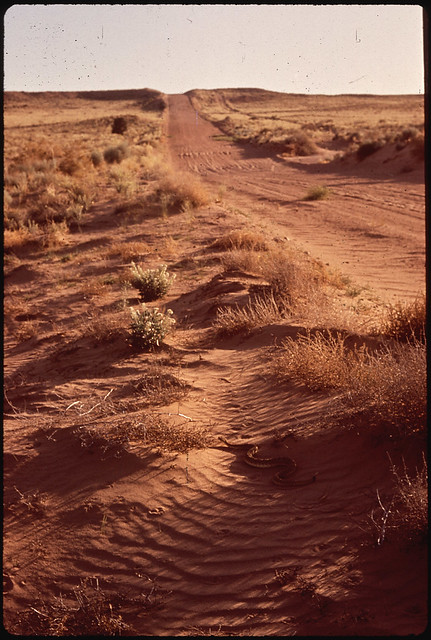
The sand can become airborn, for instance when it is windy. Or, if there is sand that has settled on a roadway, the draft from passing vehicles disturbs the sand, kicking it up into the air.
See:

As we all know, when the engine is running it creates vacuum. This is the same principle by which a Vacuum Cleaner works. This is why an air filter is required. However, the seals in the intake, which are after the air filters, had failed = leaking = air enters bypassing the filter.
In addition to bad seals, there was at least one vacuum line that had a crack that was wide open, about the same diameter as the inside diameter of the tube, therefore it was also sucking in air from outside, bypassing the filter...
"Looks like carbon build up to me.....oil in the intake system" Hmm, I think that's why I said:
So why would there be oil in the intake? This would be from the Crankcase ventilation system, which feeds into the manifold. As vapor and gases from combustion (blow-by) pass out through the vent tubes, they take along with them tiny droplets of oil. This is why occasionally the covers must be removed, and the orifice through which these gases vent, must be carefully cleaned. It is also why some people find that these hoses have become clogged and must replace them.
Fuel vapors may form, for instance when the engine is off (No Vacuum), but is still warm. These vapors will diffuse, possibly finding their way into the manifold. As the engine cools they condense, forming deposits on the surfaces inside the manifold and ports. Hence, why I said
See, sand. This is an example of some undeveloped land near where I live.

The sand can become airborn, for instance when it is windy. Or, if there is sand that has settled on a roadway, the draft from passing vehicles disturbs the sand, kicking it up into the air.
See:

As we all know, when the engine is running it creates vacuum. This is the same principle by which a Vacuum Cleaner works. This is why an air filter is required. However, the seals in the intake, which are after the air filters, had failed = leaking = air enters bypassing the filter.
During reassembly, I replaced all the rubber seals between the throttle actuator and the air filter housing. Again, the heat had caused all these seals to shrink and harden, leaving a gap for air to sneak by, bypassing the air filters, and in the case of the lower seals, also bypassing the MAF. This was probably the main cause of sand getting sucked into the motor.
Upon further inspection, I found a line that actually had an open hole in it
The black stuff in all these photos is sand covered with gas/oil...
Fuel vapors may form, for instance when the engine is off (No Vacuum), but is still warm. These vapors will diffuse, possibly finding their way into the manifold. As the engine cools they condense, forming deposits on the surfaces inside the manifold and ports. Hence, why I said
The black stuff in all these photos is sand covered with gas/oil...
#14
Member
Join Date: Jun 2010
Location: San Diego
Posts: 195
Likes: 0
Received 0 Likes
on
0 Posts
02 CLK430
Yea i saw what you wrote, and if that much sand got in your intake I would be more concerned with your cylinder walls and piston rings. Oil in the intake happens due to crankcase ventilation, hence why some people run oil seperators to remove oil from the intake track. It can also be caused due to excessive blow by and crappy valve steam seals. If it were trully all sand, i think you have bigger things to worry about over time than just sand was in the intake. Its true, some may be sand but IMHO i think its oil build up from cankcase ventilation. How does the oil cap look like when you take it off? How are the breahter assemblies on the valve covers? Get some sealant ready, pop off the breathers and see how they look. It will probably look like the oil in the intake. And I know what the southwest is like, I 4x4 out in the desert quite a bit.
#15
Junior Member
Thread Starter
Yes, I agree, I had much bigger things to worry about than just sand in the intake, which is why I commented about contemplating parting it out on eBay. I analyzed many things before deciding to take on the repair. I have good compression in all cylinders, it does not consume an abnormal amount of oil, it does not smoke at start up or at any other time; it has excellent emissions readings, and now that I have it all put back together, with the problems corrected, it is running beautifully. I have also serviced the PCV system and when I did the repair, I replaced all the lines and it is functioning normally.
It is hard to see in the pics, but most of what you are seeing is sand. I know because not only can I see it, but if I run my finger through it, it is all sand. The same was true in the ports. In addition, when I opened the manifold, the valley down the middle had a small amount of liquid pooled up, which was fuel, not oil. I am guessing this had to do with the high fuel trim corrections it applied in response to the problems it was having.
It is hard to see in the pics, but most of what you are seeing is sand. I know because not only can I see it, but if I run my finger through it, it is all sand. The same was true in the ports. In addition, when I opened the manifold, the valley down the middle had a small amount of liquid pooled up, which was fuel, not oil. I am guessing this had to do with the high fuel trim corrections it applied in response to the problems it was having.
#16
Junior Member
Thread Starter
I should mention that I have no idea what happened before I owned the vehicle, and any number of things could have happened. I only know what I can measure/test now, and everything looks good.
I also would say, that regardless of how it got there, the oil in the intake filtered a lot of sand, which would otherwise have gone through the motor, so it may have prevented more serious engine damage.
I also would say, that regardless of how it got there, the oil in the intake filtered a lot of sand, which would otherwise have gone through the motor, so it may have prevented more serious engine damage.
Last edited by senorking; 03-27-2011 at 08:12 PM.
#17
Thanks for this, this describes my problem exactly. My car is not a salvage, its an e320 1999. I bought it at 49k and its at 120k now three years later. A MB tech who was feeling rather helpful one day gave me free advice and said it looked like a valve problem. Turns out, it lead me here after I seafoamed my engine and did a hot soak on my lines and it completely fixed it.  I'm supposing your intense cleaning is the best method because I've not fixed why it happened, just the symptom. Your guide will provide me thorough steps to follow while I deconstruct my system and clean/replace what I need to.
I'm supposing your intense cleaning is the best method because I've not fixed why it happened, just the symptom. Your guide will provide me thorough steps to follow while I deconstruct my system and clean/replace what I need to.
I really appreciate this write up. Great job!
 I'm supposing your intense cleaning is the best method because I've not fixed why it happened, just the symptom. Your guide will provide me thorough steps to follow while I deconstruct my system and clean/replace what I need to.
I'm supposing your intense cleaning is the best method because I've not fixed why it happened, just the symptom. Your guide will provide me thorough steps to follow while I deconstruct my system and clean/replace what I need to. I really appreciate this write up. Great job!
#18
Newbie
Join Date: Sep 2009
Location: Los Gatos, California
Posts: 10
Likes: 0
Received 0 Likes
on
0 Posts
Mercedes CLK430
Superb documentation! Thank you!
So, in retrospect am I correct when I say the main power issue you had was the fuel filter, followed by bad fuel, followed in part by some vacuum leaks??
Mine has the same decent idle combined with marked poor part throttle performance and some top end power reduction as well. it seems to have a flat spot on light acceleration but runs well enough to drive economically. Also, no cel yet. Thanks!

So, in retrospect am I correct when I say the main power issue you had was the fuel filter, followed by bad fuel, followed in part by some vacuum leaks??
Mine has the same decent idle combined with marked poor part throttle performance and some top end power reduction as well. it seems to have a flat spot on light acceleration but runs well enough to drive economically. Also, no cel yet. Thanks!
#19
Member
Join Date: Aug 2008
Location: upper west side, manhattan, new york
Posts: 79
Received 0 Likes
on
0 Posts
1999 CLK 320 Coupe
Even though I'm not a mechanic and have very little knowledge of the technical details of which you speak, your post was so well written and interesting that I enjoyed reading it and looking at the pics. If something like this ever happens to me I'll know where to look - although where i live we have snow not sand, and luckily snow melts on contact and turns to water vapor. If only sand did the same, right? 

#21
Banned
Join Date: Nov 2012
Posts: 331
Likes: 0
Received 8 Likes
on
8 Posts
550HP+ ///AMG CL55 Kompressor, Ducati 916bp, Yamaha R1 WSBK replica
Jesus. I'd be amazed if the sand hadn't gotten into the cylinders, scratching them up and reducing compression as well.
You should do a leakdown test on each cylinder.
You should do a leakdown test on each cylinder.
#22
Newbie
Join Date: Jan 2011
Location: france
Posts: 6
Likes: 0
Received 0 Likes
on
0 Posts
1999 clk 320 amg cabriolet upgrade
w208 no acceleration misfires etc
hi all,
have had the same problem for over a year
and have now had it fixed
a new bosch MAF
12 new plugs
fuel filter,
the fuel filter was the last piece in the jigsaw,
anyway all is good,just how it should be.
mike
have had the same problem for over a year
and have now had it fixed
a new bosch MAF
12 new plugs
fuel filter,
the fuel filter was the last piece in the jigsaw,
anyway all is good,just how it should be.
mike
#23
Junior Member
Join Date: May 2009
Location: Garden Grove, Ca.
Posts: 42
Likes: 0
Received 0 Likes
on
0 Posts
2004 CLK500 Cab
Excellent write up Senor. WOW with all that sand out there you may want to put some woman's nylons on the end of those intake breathers for added blocking. Air flow disturbance should be minute. I use to put some nylon's on my 86 Mustang GT back in the day when I street raced. Took of the air filter for better breathing. Worked great.
#24
Excellent stuff
[QUOTE=senorking;4593950]With all due respect, I was pretty thorough explaining what happened, I'm not sure what's so confusing if you all actually read the article. The car is, and always has been, in the southwest. The southwest is comprised mostly of desert. Deserts typically contain lots of sand, like the one that I live in:
See, sand. This is an example of some undeveloped land near where I live.

The sand can become airborn, for instance when it is windy. Or, if there is sand that has settled on a roadway, the draft from passing vehicles disturbs the sand, kicking it up into the air.
See:

As we all know, when the engine is running it creates vacuum. This is the same principle by which a Vacuum Cleaner works. This is why an air filter is required. However, the seals in the intake, which are after the air filters, had failed = leaking = air enters bypassing the filter.
Excellent peace very well explained nice pictures wish there where more like you willing to help people out with such details and giving you're time . Don't really understand all the smart remarks you're getting about salvage anyone with half a brain sell would understand the vacuum will suck in sand very easy into the engine when dry sand is in the air or any dust for that matter ,
Why do they think the car has a air filter in the first place haha .
Ah well what can you do there is always someone how want to run someon down when they are unable to match there skill or there kindness in helping other .
I thank you very much for you peace it will help me a lot I would say .
See, sand. This is an example of some undeveloped land near where I live.

The sand can become airborn, for instance when it is windy. Or, if there is sand that has settled on a roadway, the draft from passing vehicles disturbs the sand, kicking it up into the air.
See:

As we all know, when the engine is running it creates vacuum. This is the same principle by which a Vacuum Cleaner works. This is why an air filter is required. However, the seals in the intake, which are after the air filters, had failed = leaking = air enters bypassing the filter.
Excellent peace very well explained nice pictures wish there where more like you willing to help people out with such details and giving you're time . Don't really understand all the smart remarks you're getting about salvage anyone with half a brain sell would understand the vacuum will suck in sand very easy into the engine when dry sand is in the air or any dust for that matter ,
Why do they think the car has a air filter in the first place haha .
Ah well what can you do there is always someone how want to run someon down when they are unable to match there skill or there kindness in helping other .
I thank you very much for you peace it will help me a lot I would say .
#25
Its amazing the thing ran that good after all was finished. That engine sucked a lot of sand. Maybe its a good thing the sand is large granules, if it was just very fine dust it may do more damage to cylinder walls. So is there a gasket between upper and lower manifolds or just a sealer? I wonder how many of these engines are on the verge of this sort of problem? How many miles on the car when you did all this?








